Analysis of Education Sector Reforms in Australia: An Overview
VerifiedAdded on 2020/04/01
|16
|4066
|145
Report
AI Summary
This report provides an in-depth analysis of the reforms implemented in the Australian education sector. It examines the government's focus on education as a key driver of economic and social success, emphasizing the importance of investment in human capital. The report details the various bills and policies introduced by the Australian Senate to improve schools and universities, including changes to funding models, such as the Higher Education Loan Programme (HELP), and the impact of these changes on students and universities. It analyzes the shift in funding responsibilities, the introduction of performance-contingent funding, and the deregulation of tuition fees. The report also discusses the government's efforts to improve the quality of education, increase accountability and transparency, and provide more choices for students. It covers the expansion of regional study centers, the focus on student learning capabilities, and the need for proper planning and evaluation of reforms, while also mentioning the importance of learning from other countries. The report highlights the factors associated with successful educational reforms, the role of the Australian government, and the financing system of each sector to improve tertiary education. It also discusses the expansion of the higher education system in Australia and the benefits of the HELP programme, including reduced student burdens and increased access to education for diverse economic backgrounds.
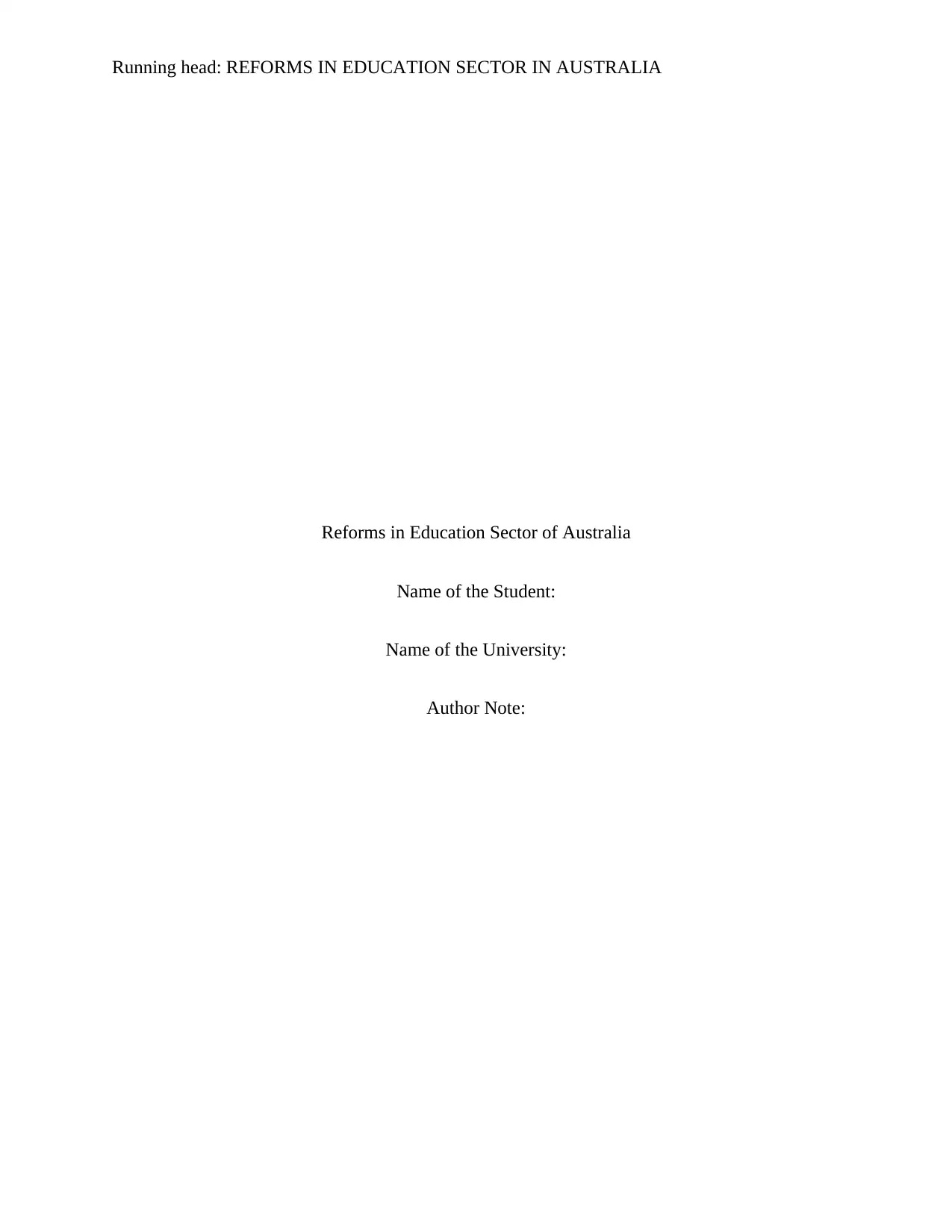
Running head: REFORMS IN EDUCATION SECTOR IN AUSTRALIA
Reforms in Education Sector of Australia
Name of the Student:
Name of the University:
Author Note:
Reforms in Education Sector of Australia
Name of the Student:
Name of the University:
Author Note:
Paraphrase This Document
Need a fresh take? Get an instant paraphrase of this document with our AI Paraphraser
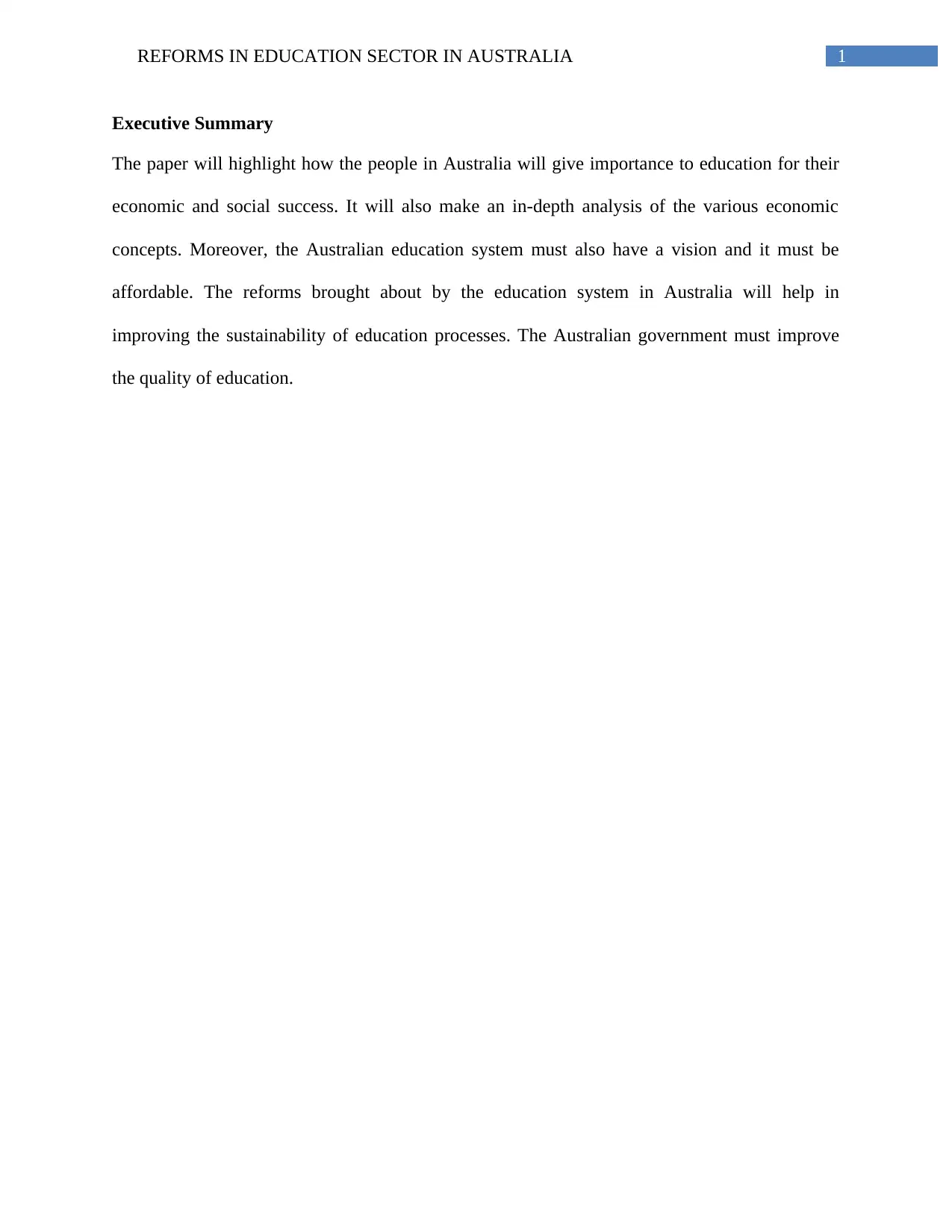
1REFORMS IN EDUCATION SECTOR IN AUSTRALIA
Executive Summary
The paper will highlight how the people in Australia will give importance to education for their
economic and social success. It will also make an in-depth analysis of the various economic
concepts. Moreover, the Australian education system must also have a vision and it must be
affordable. The reforms brought about by the education system in Australia will help in
improving the sustainability of education processes. The Australian government must improve
the quality of education.
Executive Summary
The paper will highlight how the people in Australia will give importance to education for their
economic and social success. It will also make an in-depth analysis of the various economic
concepts. Moreover, the Australian education system must also have a vision and it must be
affordable. The reforms brought about by the education system in Australia will help in
improving the sustainability of education processes. The Australian government must improve
the quality of education.
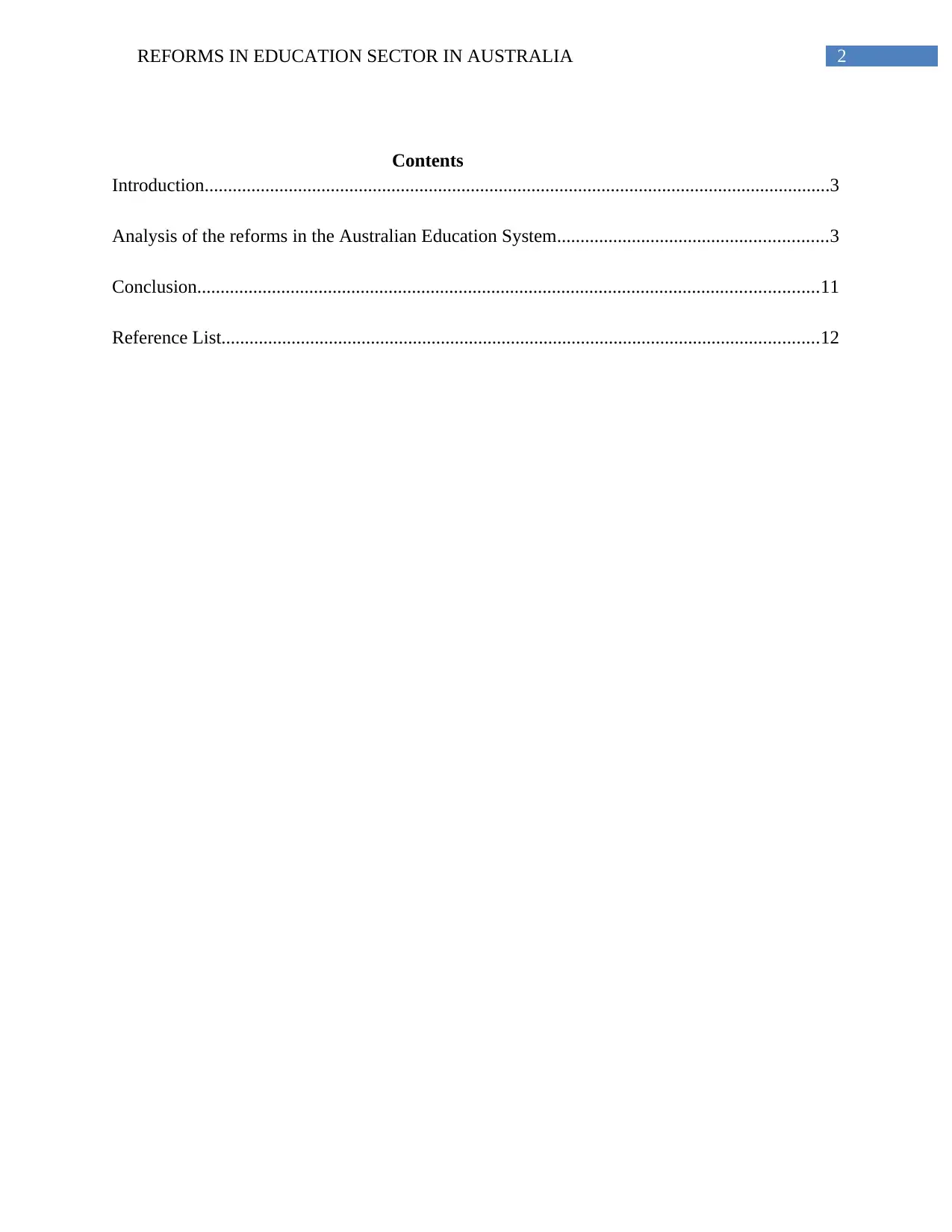
2REFORMS IN EDUCATION SECTOR IN AUSTRALIA
Contents
Introduction......................................................................................................................................3
Analysis of the reforms in the Australian Education System..........................................................3
Conclusion.....................................................................................................................................11
Reference List................................................................................................................................12
Contents
Introduction......................................................................................................................................3
Analysis of the reforms in the Australian Education System..........................................................3
Conclusion.....................................................................................................................................11
Reference List................................................................................................................................12
⊘ This is a preview!⊘
Do you want full access?
Subscribe today to unlock all pages.

Trusted by 1+ million students worldwide
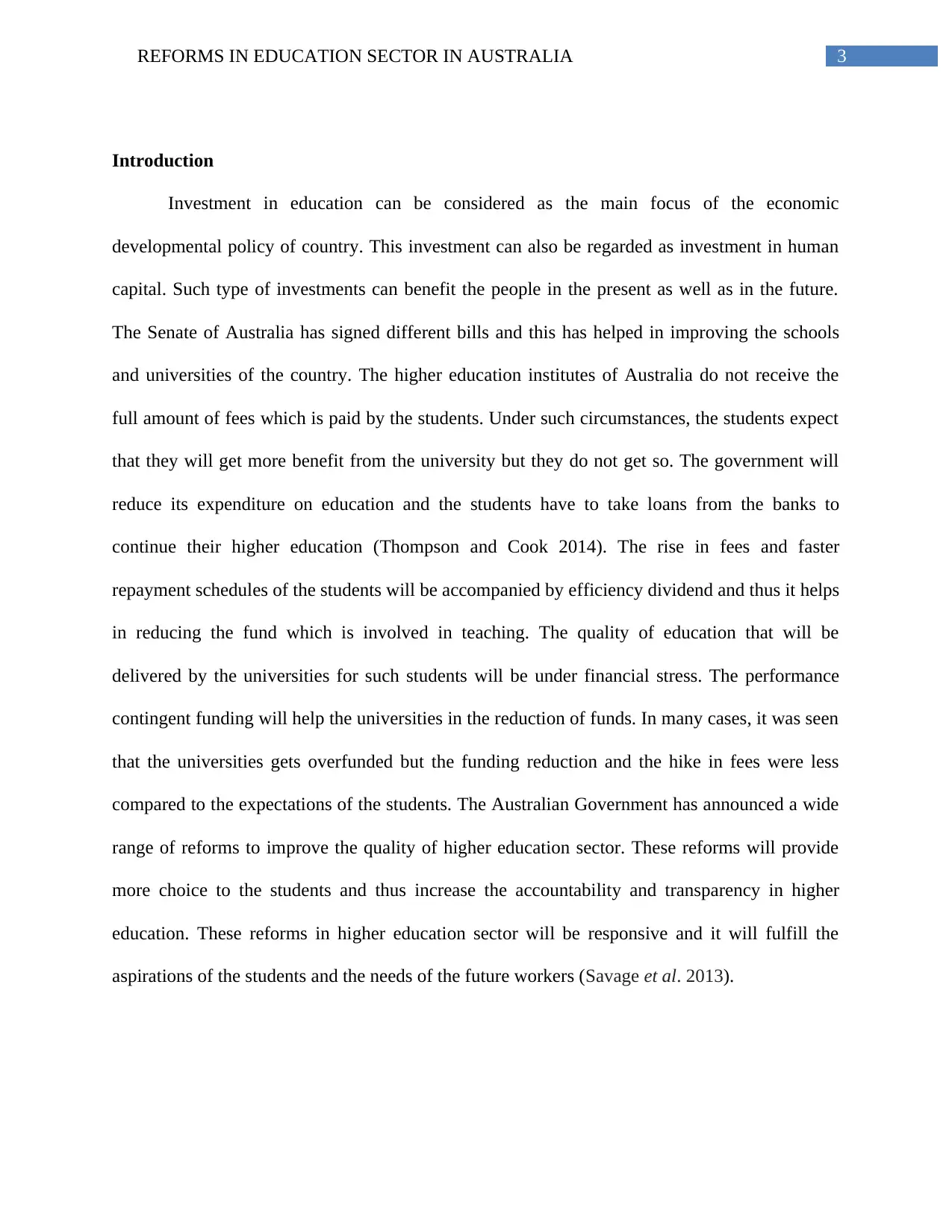
3REFORMS IN EDUCATION SECTOR IN AUSTRALIA
Introduction
Investment in education can be considered as the main focus of the economic
developmental policy of country. This investment can also be regarded as investment in human
capital. Such type of investments can benefit the people in the present as well as in the future.
The Senate of Australia has signed different bills and this has helped in improving the schools
and universities of the country. The higher education institutes of Australia do not receive the
full amount of fees which is paid by the students. Under such circumstances, the students expect
that they will get more benefit from the university but they do not get so. The government will
reduce its expenditure on education and the students have to take loans from the banks to
continue their higher education (Thompson and Cook 2014). The rise in fees and faster
repayment schedules of the students will be accompanied by efficiency dividend and thus it helps
in reducing the fund which is involved in teaching. The quality of education that will be
delivered by the universities for such students will be under financial stress. The performance
contingent funding will help the universities in the reduction of funds. In many cases, it was seen
that the universities gets overfunded but the funding reduction and the hike in fees were less
compared to the expectations of the students. The Australian Government has announced a wide
range of reforms to improve the quality of higher education sector. These reforms will provide
more choice to the students and thus increase the accountability and transparency in higher
education. These reforms in higher education sector will be responsive and it will fulfill the
aspirations of the students and the needs of the future workers (Savage et al. 2013).
Introduction
Investment in education can be considered as the main focus of the economic
developmental policy of country. This investment can also be regarded as investment in human
capital. Such type of investments can benefit the people in the present as well as in the future.
The Senate of Australia has signed different bills and this has helped in improving the schools
and universities of the country. The higher education institutes of Australia do not receive the
full amount of fees which is paid by the students. Under such circumstances, the students expect
that they will get more benefit from the university but they do not get so. The government will
reduce its expenditure on education and the students have to take loans from the banks to
continue their higher education (Thompson and Cook 2014). The rise in fees and faster
repayment schedules of the students will be accompanied by efficiency dividend and thus it helps
in reducing the fund which is involved in teaching. The quality of education that will be
delivered by the universities for such students will be under financial stress. The performance
contingent funding will help the universities in the reduction of funds. In many cases, it was seen
that the universities gets overfunded but the funding reduction and the hike in fees were less
compared to the expectations of the students. The Australian Government has announced a wide
range of reforms to improve the quality of higher education sector. These reforms will provide
more choice to the students and thus increase the accountability and transparency in higher
education. These reforms in higher education sector will be responsive and it will fulfill the
aspirations of the students and the needs of the future workers (Savage et al. 2013).
Paraphrase This Document
Need a fresh take? Get an instant paraphrase of this document with our AI Paraphraser
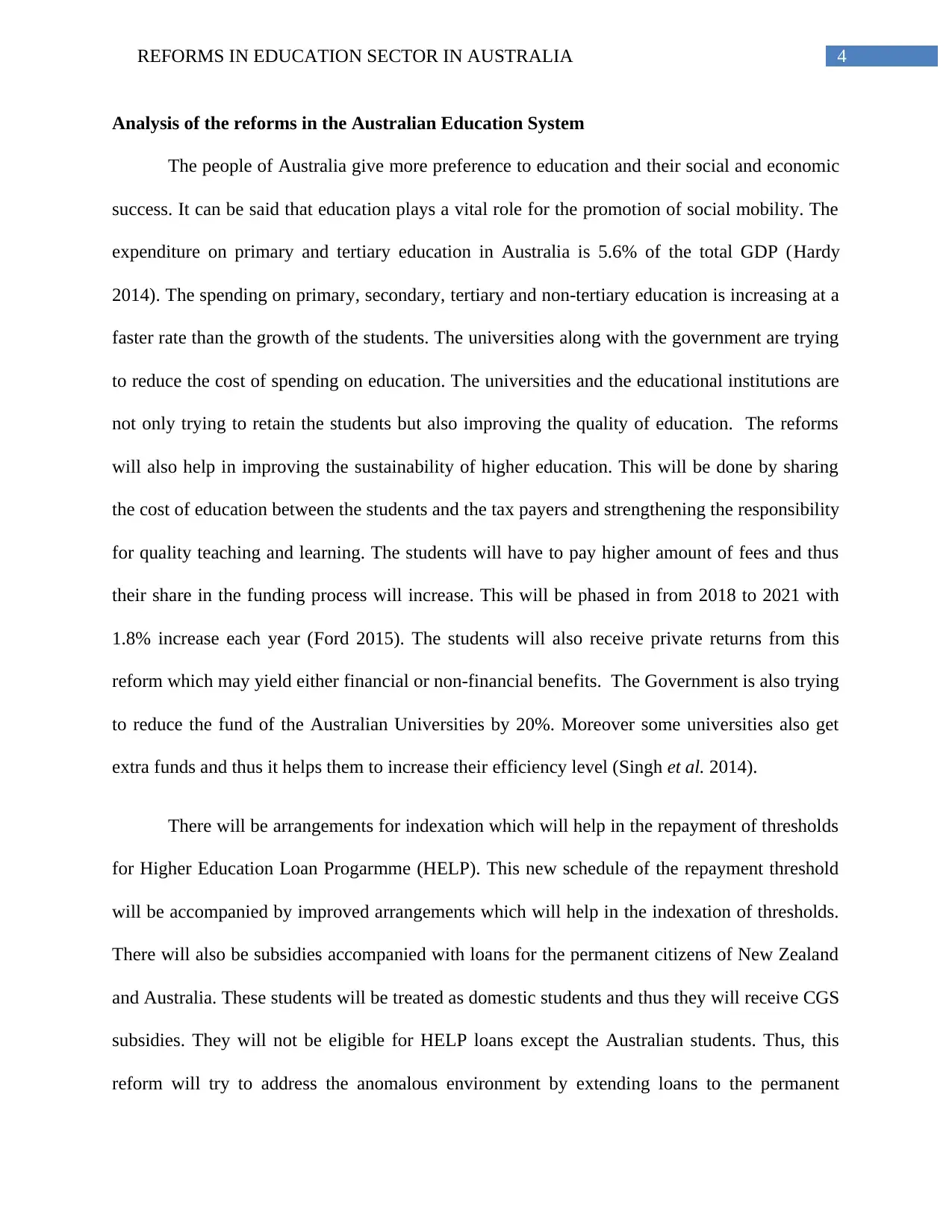
4REFORMS IN EDUCATION SECTOR IN AUSTRALIA
Analysis of the reforms in the Australian Education System
The people of Australia give more preference to education and their social and economic
success. It can be said that education plays a vital role for the promotion of social mobility. The
expenditure on primary and tertiary education in Australia is 5.6% of the total GDP (Hardy
2014). The spending on primary, secondary, tertiary and non-tertiary education is increasing at a
faster rate than the growth of the students. The universities along with the government are trying
to reduce the cost of spending on education. The universities and the educational institutions are
not only trying to retain the students but also improving the quality of education. The reforms
will also help in improving the sustainability of higher education. This will be done by sharing
the cost of education between the students and the tax payers and strengthening the responsibility
for quality teaching and learning. The students will have to pay higher amount of fees and thus
their share in the funding process will increase. This will be phased in from 2018 to 2021 with
1.8% increase each year (Ford 2015). The students will also receive private returns from this
reform which may yield either financial or non-financial benefits. The Government is also trying
to reduce the fund of the Australian Universities by 20%. Moreover some universities also get
extra funds and thus it helps them to increase their efficiency level (Singh et al. 2014).
There will be arrangements for indexation which will help in the repayment of thresholds
for Higher Education Loan Progarmme (HELP). This new schedule of the repayment threshold
will be accompanied by improved arrangements which will help in the indexation of thresholds.
There will also be subsidies accompanied with loans for the permanent citizens of New Zealand
and Australia. These students will be treated as domestic students and thus they will receive CGS
subsidies. They will not be eligible for HELP loans except the Australian students. Thus, this
reform will try to address the anomalous environment by extending loans to the permanent
Analysis of the reforms in the Australian Education System
The people of Australia give more preference to education and their social and economic
success. It can be said that education plays a vital role for the promotion of social mobility. The
expenditure on primary and tertiary education in Australia is 5.6% of the total GDP (Hardy
2014). The spending on primary, secondary, tertiary and non-tertiary education is increasing at a
faster rate than the growth of the students. The universities along with the government are trying
to reduce the cost of spending on education. The universities and the educational institutions are
not only trying to retain the students but also improving the quality of education. The reforms
will also help in improving the sustainability of higher education. This will be done by sharing
the cost of education between the students and the tax payers and strengthening the responsibility
for quality teaching and learning. The students will have to pay higher amount of fees and thus
their share in the funding process will increase. This will be phased in from 2018 to 2021 with
1.8% increase each year (Ford 2015). The students will also receive private returns from this
reform which may yield either financial or non-financial benefits. The Government is also trying
to reduce the fund of the Australian Universities by 20%. Moreover some universities also get
extra funds and thus it helps them to increase their efficiency level (Singh et al. 2014).
There will be arrangements for indexation which will help in the repayment of thresholds
for Higher Education Loan Progarmme (HELP). This new schedule of the repayment threshold
will be accompanied by improved arrangements which will help in the indexation of thresholds.
There will also be subsidies accompanied with loans for the permanent citizens of New Zealand
and Australia. These students will be treated as domestic students and thus they will receive CGS
subsidies. They will not be eligible for HELP loans except the Australian students. Thus, this
reform will try to address the anomalous environment by extending loans to the permanent
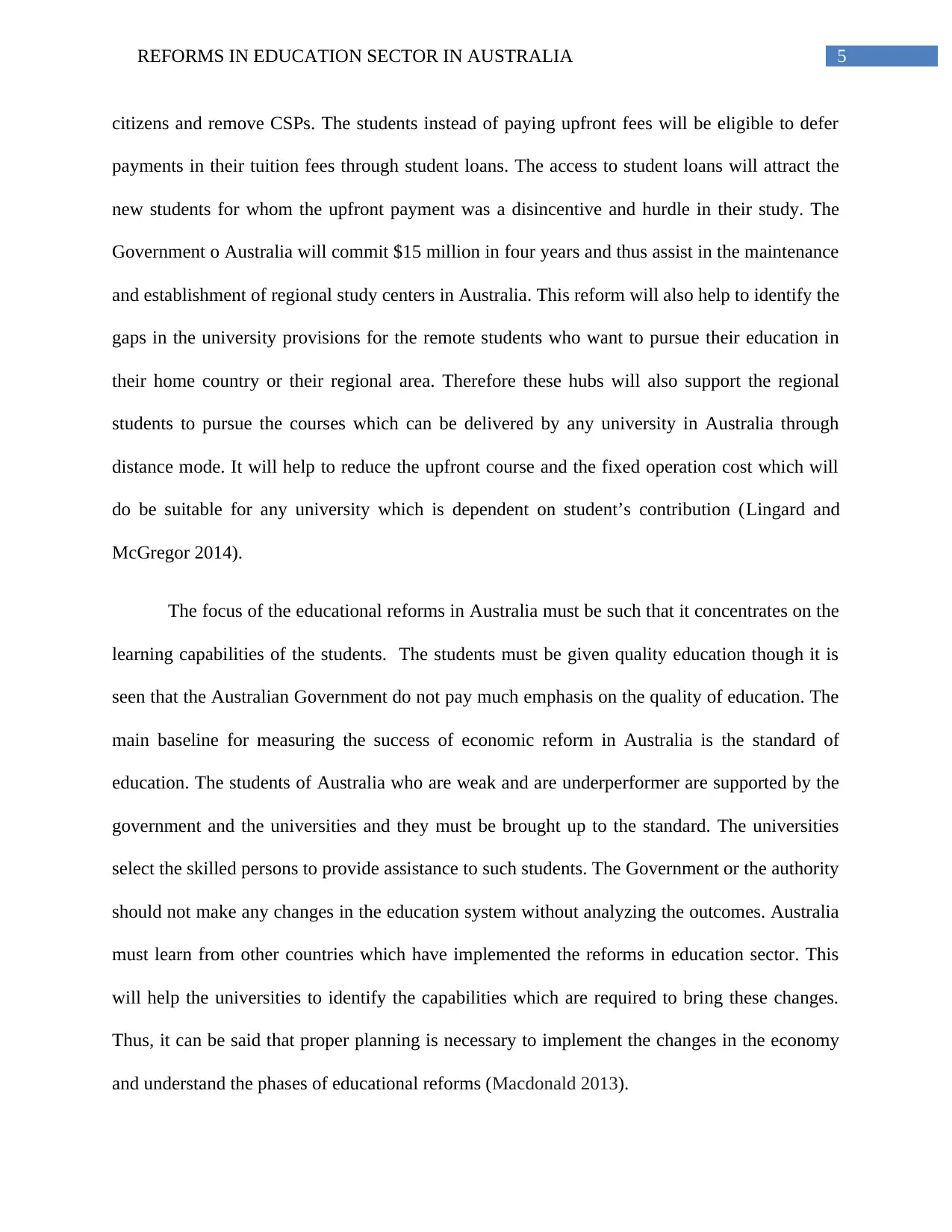
5REFORMS IN EDUCATION SECTOR IN AUSTRALIA
citizens and remove CSPs. The students instead of paying upfront fees will be eligible to defer
payments in their tuition fees through student loans. The access to student loans will attract the
new students for whom the upfront payment was a disincentive and hurdle in their study. The
Government o Australia will commit $15 million in four years and thus assist in the maintenance
and establishment of regional study centers in Australia. This reform will also help to identify the
gaps in the university provisions for the remote students who want to pursue their education in
their home country or their regional area. Therefore these hubs will also support the regional
students to pursue the courses which can be delivered by any university in Australia through
distance mode. It will help to reduce the upfront course and the fixed operation cost which will
do be suitable for any university which is dependent on student’s contribution (Lingard and
McGregor 2014).
The focus of the educational reforms in Australia must be such that it concentrates on the
learning capabilities of the students. The students must be given quality education though it is
seen that the Australian Government do not pay much emphasis on the quality of education. The
main baseline for measuring the success of economic reform in Australia is the standard of
education. The students of Australia who are weak and are underperformer are supported by the
government and the universities and they must be brought up to the standard. The universities
select the skilled persons to provide assistance to such students. The Government or the authority
should not make any changes in the education system without analyzing the outcomes. Australia
must learn from other countries which have implemented the reforms in education sector. This
will help the universities to identify the capabilities which are required to bring these changes.
Thus, it can be said that proper planning is necessary to implement the changes in the economy
and understand the phases of educational reforms (Macdonald 2013).
citizens and remove CSPs. The students instead of paying upfront fees will be eligible to defer
payments in their tuition fees through student loans. The access to student loans will attract the
new students for whom the upfront payment was a disincentive and hurdle in their study. The
Government o Australia will commit $15 million in four years and thus assist in the maintenance
and establishment of regional study centers in Australia. This reform will also help to identify the
gaps in the university provisions for the remote students who want to pursue their education in
their home country or their regional area. Therefore these hubs will also support the regional
students to pursue the courses which can be delivered by any university in Australia through
distance mode. It will help to reduce the upfront course and the fixed operation cost which will
do be suitable for any university which is dependent on student’s contribution (Lingard and
McGregor 2014).
The focus of the educational reforms in Australia must be such that it concentrates on the
learning capabilities of the students. The students must be given quality education though it is
seen that the Australian Government do not pay much emphasis on the quality of education. The
main baseline for measuring the success of economic reform in Australia is the standard of
education. The students of Australia who are weak and are underperformer are supported by the
government and the universities and they must be brought up to the standard. The universities
select the skilled persons to provide assistance to such students. The Government or the authority
should not make any changes in the education system without analyzing the outcomes. Australia
must learn from other countries which have implemented the reforms in education sector. This
will help the universities to identify the capabilities which are required to bring these changes.
Thus, it can be said that proper planning is necessary to implement the changes in the economy
and understand the phases of educational reforms (Macdonald 2013).
⊘ This is a preview!⊘
Do you want full access?
Subscribe today to unlock all pages.

Trusted by 1+ million students worldwide
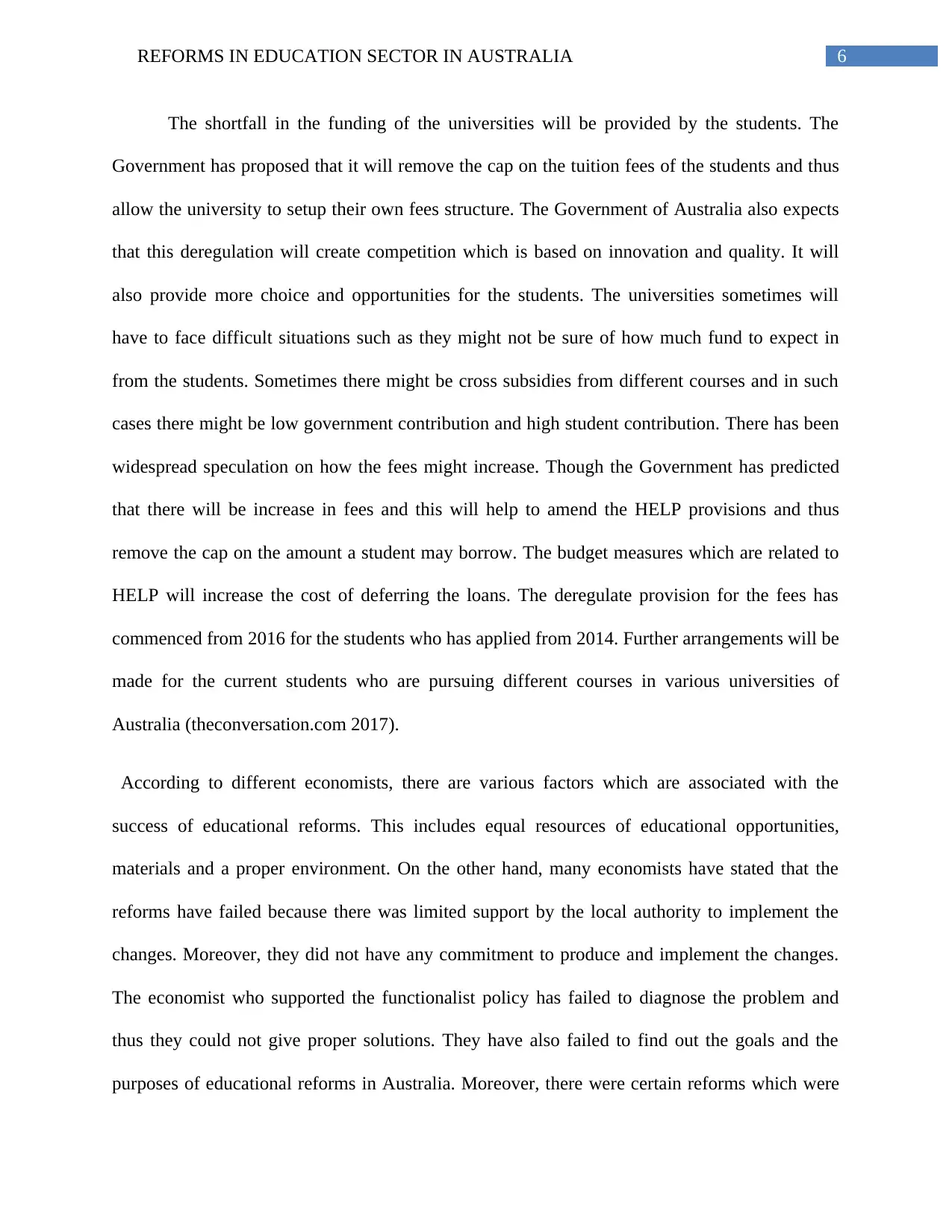
6REFORMS IN EDUCATION SECTOR IN AUSTRALIA
The shortfall in the funding of the universities will be provided by the students. The
Government has proposed that it will remove the cap on the tuition fees of the students and thus
allow the university to setup their own fees structure. The Government of Australia also expects
that this deregulation will create competition which is based on innovation and quality. It will
also provide more choice and opportunities for the students. The universities sometimes will
have to face difficult situations such as they might not be sure of how much fund to expect in
from the students. Sometimes there might be cross subsidies from different courses and in such
cases there might be low government contribution and high student contribution. There has been
widespread speculation on how the fees might increase. Though the Government has predicted
that there will be increase in fees and this will help to amend the HELP provisions and thus
remove the cap on the amount a student may borrow. The budget measures which are related to
HELP will increase the cost of deferring the loans. The deregulate provision for the fees has
commenced from 2016 for the students who has applied from 2014. Further arrangements will be
made for the current students who are pursuing different courses in various universities of
Australia (theconversation.com 2017).
According to different economists, there are various factors which are associated with the
success of educational reforms. This includes equal resources of educational opportunities,
materials and a proper environment. On the other hand, many economists have stated that the
reforms have failed because there was limited support by the local authority to implement the
changes. Moreover, they did not have any commitment to produce and implement the changes.
The economist who supported the functionalist policy has failed to diagnose the problem and
thus they could not give proper solutions. They have also failed to find out the goals and the
purposes of educational reforms in Australia. Moreover, there were certain reforms which were
The shortfall in the funding of the universities will be provided by the students. The
Government has proposed that it will remove the cap on the tuition fees of the students and thus
allow the university to setup their own fees structure. The Government of Australia also expects
that this deregulation will create competition which is based on innovation and quality. It will
also provide more choice and opportunities for the students. The universities sometimes will
have to face difficult situations such as they might not be sure of how much fund to expect in
from the students. Sometimes there might be cross subsidies from different courses and in such
cases there might be low government contribution and high student contribution. There has been
widespread speculation on how the fees might increase. Though the Government has predicted
that there will be increase in fees and this will help to amend the HELP provisions and thus
remove the cap on the amount a student may borrow. The budget measures which are related to
HELP will increase the cost of deferring the loans. The deregulate provision for the fees has
commenced from 2016 for the students who has applied from 2014. Further arrangements will be
made for the current students who are pursuing different courses in various universities of
Australia (theconversation.com 2017).
According to different economists, there are various factors which are associated with the
success of educational reforms. This includes equal resources of educational opportunities,
materials and a proper environment. On the other hand, many economists have stated that the
reforms have failed because there was limited support by the local authority to implement the
changes. Moreover, they did not have any commitment to produce and implement the changes.
The economist who supported the functionalist policy has failed to diagnose the problem and
thus they could not give proper solutions. They have also failed to find out the goals and the
purposes of educational reforms in Australia. Moreover, there were certain reforms which were
Paraphrase This Document
Need a fresh take? Get an instant paraphrase of this document with our AI Paraphraser
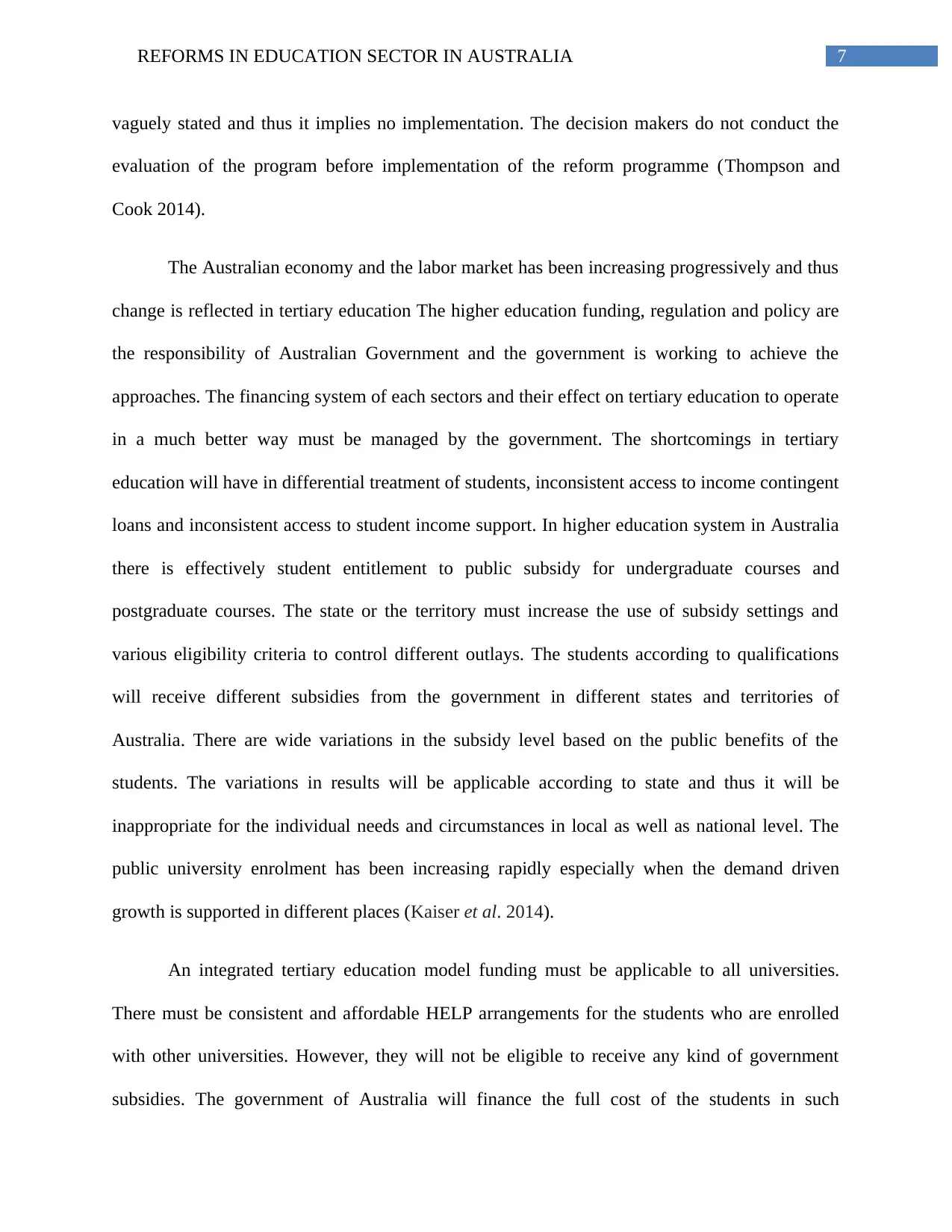
7REFORMS IN EDUCATION SECTOR IN AUSTRALIA
vaguely stated and thus it implies no implementation. The decision makers do not conduct the
evaluation of the program before implementation of the reform programme (Thompson and
Cook 2014).
The Australian economy and the labor market has been increasing progressively and thus
change is reflected in tertiary education The higher education funding, regulation and policy are
the responsibility of Australian Government and the government is working to achieve the
approaches. The financing system of each sectors and their effect on tertiary education to operate
in a much better way must be managed by the government. The shortcomings in tertiary
education will have in differential treatment of students, inconsistent access to income contingent
loans and inconsistent access to student income support. In higher education system in Australia
there is effectively student entitlement to public subsidy for undergraduate courses and
postgraduate courses. The state or the territory must increase the use of subsidy settings and
various eligibility criteria to control different outlays. The students according to qualifications
will receive different subsidies from the government in different states and territories of
Australia. There are wide variations in the subsidy level based on the public benefits of the
students. The variations in results will be applicable according to state and thus it will be
inappropriate for the individual needs and circumstances in local as well as national level. The
public university enrolment has been increasing rapidly especially when the demand driven
growth is supported in different places (Kaiser et al. 2014).
An integrated tertiary education model funding must be applicable to all universities.
There must be consistent and affordable HELP arrangements for the students who are enrolled
with other universities. However, they will not be eligible to receive any kind of government
subsidies. The government of Australia will finance the full cost of the students in such
vaguely stated and thus it implies no implementation. The decision makers do not conduct the
evaluation of the program before implementation of the reform programme (Thompson and
Cook 2014).
The Australian economy and the labor market has been increasing progressively and thus
change is reflected in tertiary education The higher education funding, regulation and policy are
the responsibility of Australian Government and the government is working to achieve the
approaches. The financing system of each sectors and their effect on tertiary education to operate
in a much better way must be managed by the government. The shortcomings in tertiary
education will have in differential treatment of students, inconsistent access to income contingent
loans and inconsistent access to student income support. In higher education system in Australia
there is effectively student entitlement to public subsidy for undergraduate courses and
postgraduate courses. The state or the territory must increase the use of subsidy settings and
various eligibility criteria to control different outlays. The students according to qualifications
will receive different subsidies from the government in different states and territories of
Australia. There are wide variations in the subsidy level based on the public benefits of the
students. The variations in results will be applicable according to state and thus it will be
inappropriate for the individual needs and circumstances in local as well as national level. The
public university enrolment has been increasing rapidly especially when the demand driven
growth is supported in different places (Kaiser et al. 2014).
An integrated tertiary education model funding must be applicable to all universities.
There must be consistent and affordable HELP arrangements for the students who are enrolled
with other universities. However, they will not be eligible to receive any kind of government
subsidies. The government of Australia will finance the full cost of the students in such
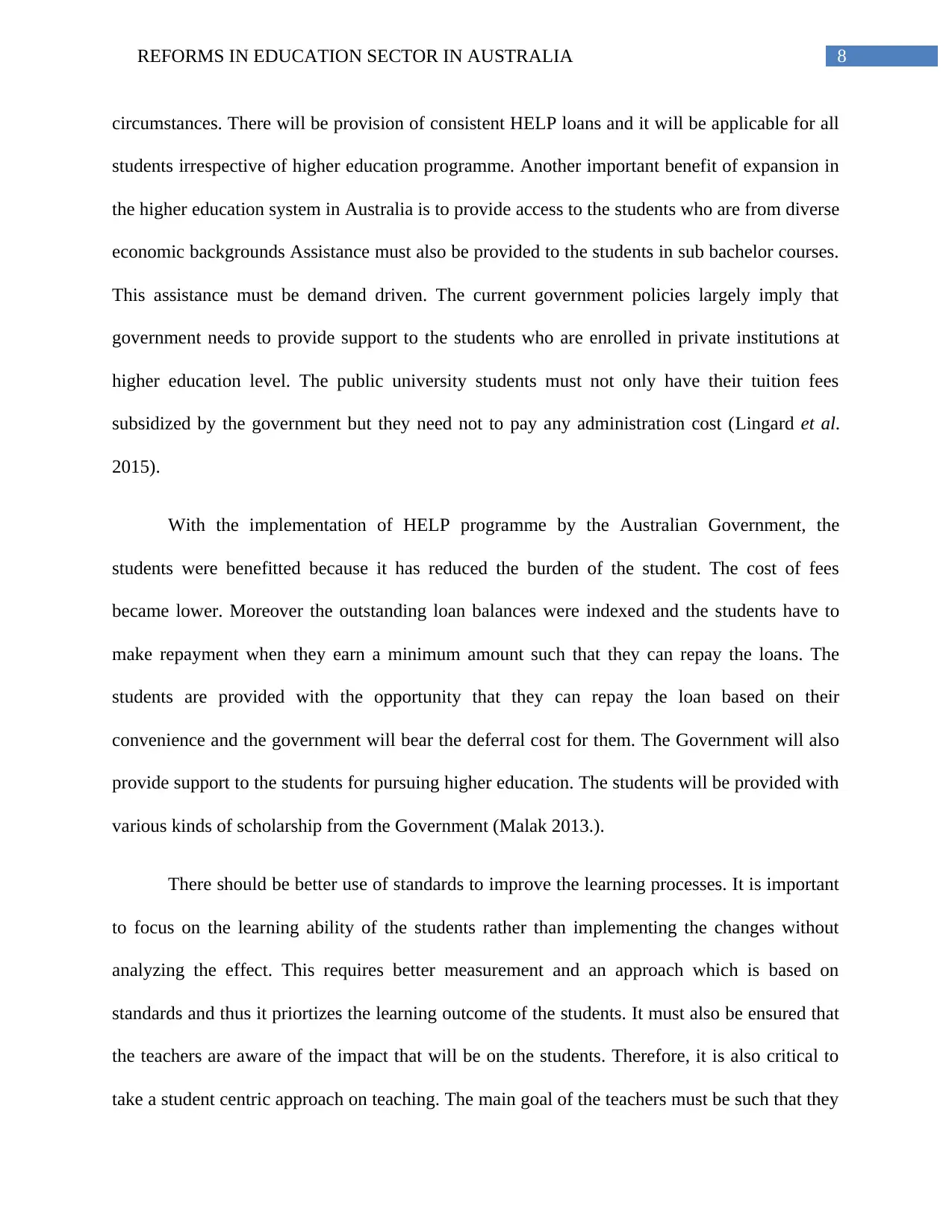
8REFORMS IN EDUCATION SECTOR IN AUSTRALIA
circumstances. There will be provision of consistent HELP loans and it will be applicable for all
students irrespective of higher education programme. Another important benefit of expansion in
the higher education system in Australia is to provide access to the students who are from diverse
economic backgrounds Assistance must also be provided to the students in sub bachelor courses.
This assistance must be demand driven. The current government policies largely imply that
government needs to provide support to the students who are enrolled in private institutions at
higher education level. The public university students must not only have their tuition fees
subsidized by the government but they need not to pay any administration cost (Lingard et al.
2015).
With the implementation of HELP programme by the Australian Government, the
students were benefitted because it has reduced the burden of the student. The cost of fees
became lower. Moreover the outstanding loan balances were indexed and the students have to
make repayment when they earn a minimum amount such that they can repay the loans. The
students are provided with the opportunity that they can repay the loan based on their
convenience and the government will bear the deferral cost for them. The Government will also
provide support to the students for pursuing higher education. The students will be provided with
various kinds of scholarship from the Government (Malak 2013.).
There should be better use of standards to improve the learning processes. It is important
to focus on the learning ability of the students rather than implementing the changes without
analyzing the effect. This requires better measurement and an approach which is based on
standards and thus it priortizes the learning outcome of the students. It must also be ensured that
the teachers are aware of the impact that will be on the students. Therefore, it is also critical to
take a student centric approach on teaching. The main goal of the teachers must be such that they
circumstances. There will be provision of consistent HELP loans and it will be applicable for all
students irrespective of higher education programme. Another important benefit of expansion in
the higher education system in Australia is to provide access to the students who are from diverse
economic backgrounds Assistance must also be provided to the students in sub bachelor courses.
This assistance must be demand driven. The current government policies largely imply that
government needs to provide support to the students who are enrolled in private institutions at
higher education level. The public university students must not only have their tuition fees
subsidized by the government but they need not to pay any administration cost (Lingard et al.
2015).
With the implementation of HELP programme by the Australian Government, the
students were benefitted because it has reduced the burden of the student. The cost of fees
became lower. Moreover the outstanding loan balances were indexed and the students have to
make repayment when they earn a minimum amount such that they can repay the loans. The
students are provided with the opportunity that they can repay the loan based on their
convenience and the government will bear the deferral cost for them. The Government will also
provide support to the students for pursuing higher education. The students will be provided with
various kinds of scholarship from the Government (Malak 2013.).
There should be better use of standards to improve the learning processes. It is important
to focus on the learning ability of the students rather than implementing the changes without
analyzing the effect. This requires better measurement and an approach which is based on
standards and thus it priortizes the learning outcome of the students. It must also be ensured that
the teachers are aware of the impact that will be on the students. Therefore, it is also critical to
take a student centric approach on teaching. The main goal of the teachers must be such that they
⊘ This is a preview!⊘
Do you want full access?
Subscribe today to unlock all pages.

Trusted by 1+ million students worldwide
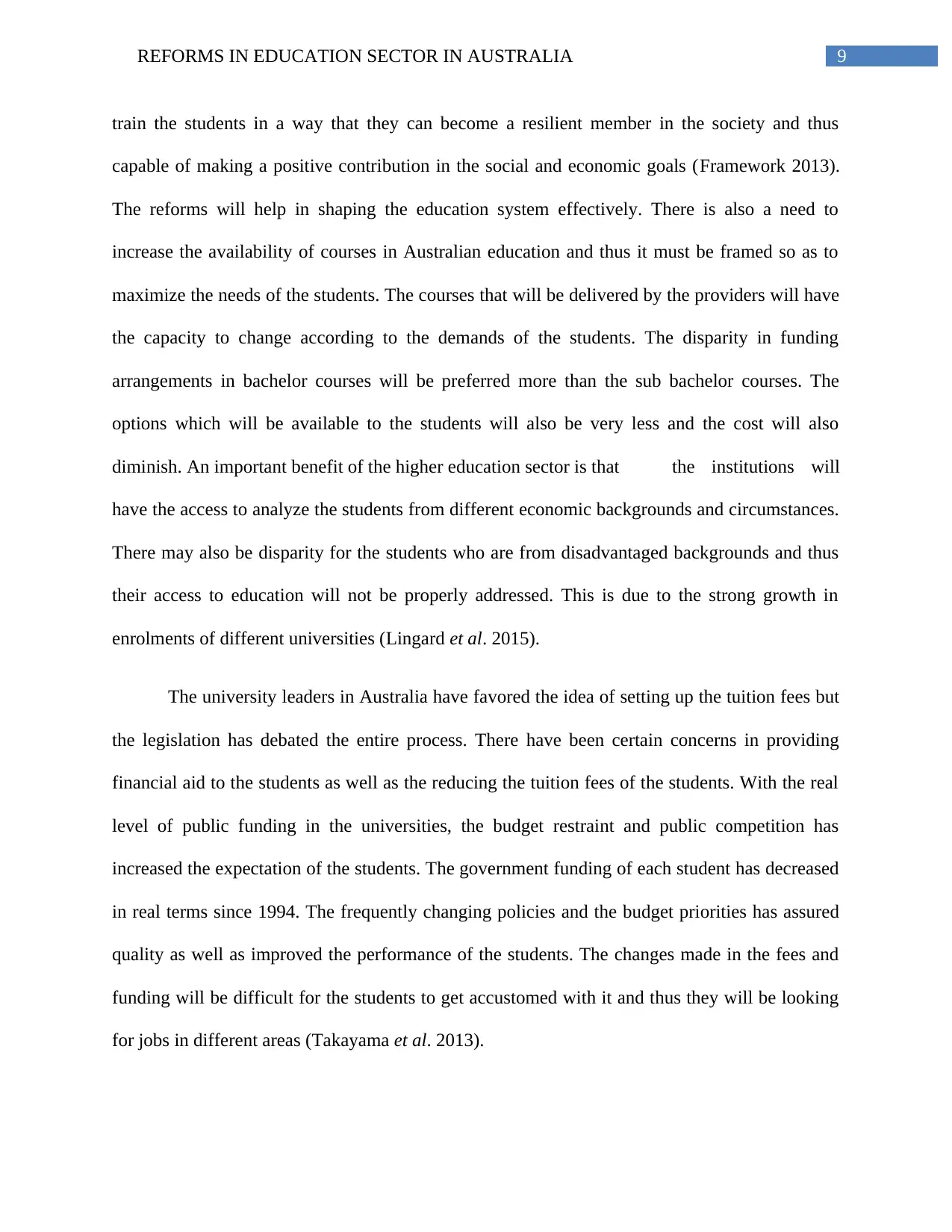
9REFORMS IN EDUCATION SECTOR IN AUSTRALIA
train the students in a way that they can become a resilient member in the society and thus
capable of making a positive contribution in the social and economic goals (Framework 2013).
The reforms will help in shaping the education system effectively. There is also a need to
increase the availability of courses in Australian education and thus it must be framed so as to
maximize the needs of the students. The courses that will be delivered by the providers will have
the capacity to change according to the demands of the students. The disparity in funding
arrangements in bachelor courses will be preferred more than the sub bachelor courses. The
options which will be available to the students will also be very less and the cost will also
diminish. An important benefit of the higher education sector is that the institutions will
have the access to analyze the students from different economic backgrounds and circumstances.
There may also be disparity for the students who are from disadvantaged backgrounds and thus
their access to education will not be properly addressed. This is due to the strong growth in
enrolments of different universities (Lingard et al. 2015).
The university leaders in Australia have favored the idea of setting up the tuition fees but
the legislation has debated the entire process. There have been certain concerns in providing
financial aid to the students as well as the reducing the tuition fees of the students. With the real
level of public funding in the universities, the budget restraint and public competition has
increased the expectation of the students. The government funding of each student has decreased
in real terms since 1994. The frequently changing policies and the budget priorities has assured
quality as well as improved the performance of the students. The changes made in the fees and
funding will be difficult for the students to get accustomed with it and thus they will be looking
for jobs in different areas (Takayama et al. 2013).
train the students in a way that they can become a resilient member in the society and thus
capable of making a positive contribution in the social and economic goals (Framework 2013).
The reforms will help in shaping the education system effectively. There is also a need to
increase the availability of courses in Australian education and thus it must be framed so as to
maximize the needs of the students. The courses that will be delivered by the providers will have
the capacity to change according to the demands of the students. The disparity in funding
arrangements in bachelor courses will be preferred more than the sub bachelor courses. The
options which will be available to the students will also be very less and the cost will also
diminish. An important benefit of the higher education sector is that the institutions will
have the access to analyze the students from different economic backgrounds and circumstances.
There may also be disparity for the students who are from disadvantaged backgrounds and thus
their access to education will not be properly addressed. This is due to the strong growth in
enrolments of different universities (Lingard et al. 2015).
The university leaders in Australia have favored the idea of setting up the tuition fees but
the legislation has debated the entire process. There have been certain concerns in providing
financial aid to the students as well as the reducing the tuition fees of the students. With the real
level of public funding in the universities, the budget restraint and public competition has
increased the expectation of the students. The government funding of each student has decreased
in real terms since 1994. The frequently changing policies and the budget priorities has assured
quality as well as improved the performance of the students. The changes made in the fees and
funding will be difficult for the students to get accustomed with it and thus they will be looking
for jobs in different areas (Takayama et al. 2013).
Paraphrase This Document
Need a fresh take? Get an instant paraphrase of this document with our AI Paraphraser
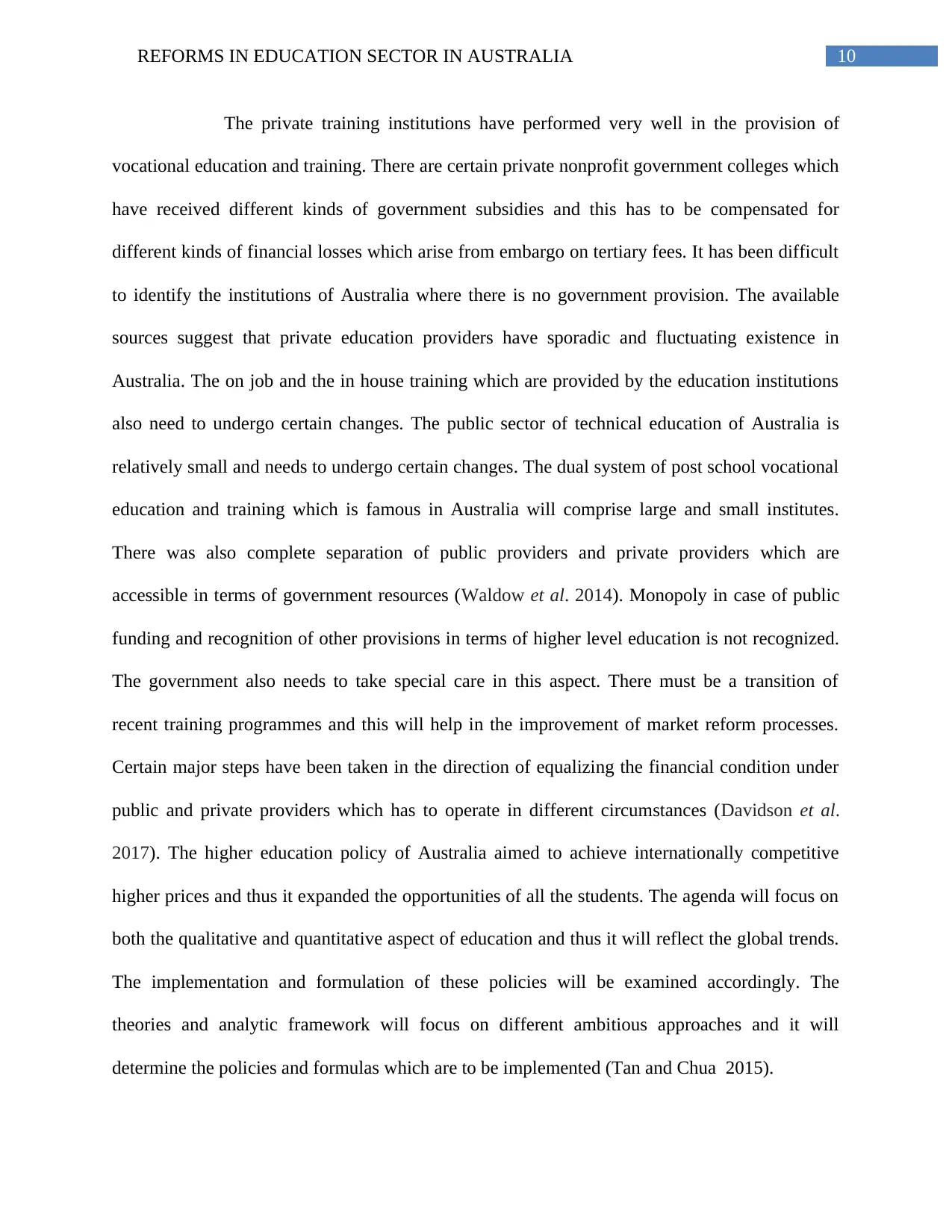
10REFORMS IN EDUCATION SECTOR IN AUSTRALIA
The private training institutions have performed very well in the provision of
vocational education and training. There are certain private nonprofit government colleges which
have received different kinds of government subsidies and this has to be compensated for
different kinds of financial losses which arise from embargo on tertiary fees. It has been difficult
to identify the institutions of Australia where there is no government provision. The available
sources suggest that private education providers have sporadic and fluctuating existence in
Australia. The on job and the in house training which are provided by the education institutions
also need to undergo certain changes. The public sector of technical education of Australia is
relatively small and needs to undergo certain changes. The dual system of post school vocational
education and training which is famous in Australia will comprise large and small institutes.
There was also complete separation of public providers and private providers which are
accessible in terms of government resources (Waldow et al. 2014). Monopoly in case of public
funding and recognition of other provisions in terms of higher level education is not recognized.
The government also needs to take special care in this aspect. There must be a transition of
recent training programmes and this will help in the improvement of market reform processes.
Certain major steps have been taken in the direction of equalizing the financial condition under
public and private providers which has to operate in different circumstances (Davidson et al.
2017). The higher education policy of Australia aimed to achieve internationally competitive
higher prices and thus it expanded the opportunities of all the students. The agenda will focus on
both the qualitative and quantitative aspect of education and thus it will reflect the global trends.
The implementation and formulation of these policies will be examined accordingly. The
theories and analytic framework will focus on different ambitious approaches and it will
determine the policies and formulas which are to be implemented (Tan and Chua 2015).
The private training institutions have performed very well in the provision of
vocational education and training. There are certain private nonprofit government colleges which
have received different kinds of government subsidies and this has to be compensated for
different kinds of financial losses which arise from embargo on tertiary fees. It has been difficult
to identify the institutions of Australia where there is no government provision. The available
sources suggest that private education providers have sporadic and fluctuating existence in
Australia. The on job and the in house training which are provided by the education institutions
also need to undergo certain changes. The public sector of technical education of Australia is
relatively small and needs to undergo certain changes. The dual system of post school vocational
education and training which is famous in Australia will comprise large and small institutes.
There was also complete separation of public providers and private providers which are
accessible in terms of government resources (Waldow et al. 2014). Monopoly in case of public
funding and recognition of other provisions in terms of higher level education is not recognized.
The government also needs to take special care in this aspect. There must be a transition of
recent training programmes and this will help in the improvement of market reform processes.
Certain major steps have been taken in the direction of equalizing the financial condition under
public and private providers which has to operate in different circumstances (Davidson et al.
2017). The higher education policy of Australia aimed to achieve internationally competitive
higher prices and thus it expanded the opportunities of all the students. The agenda will focus on
both the qualitative and quantitative aspect of education and thus it will reflect the global trends.
The implementation and formulation of these policies will be examined accordingly. The
theories and analytic framework will focus on different ambitious approaches and it will
determine the policies and formulas which are to be implemented (Tan and Chua 2015).
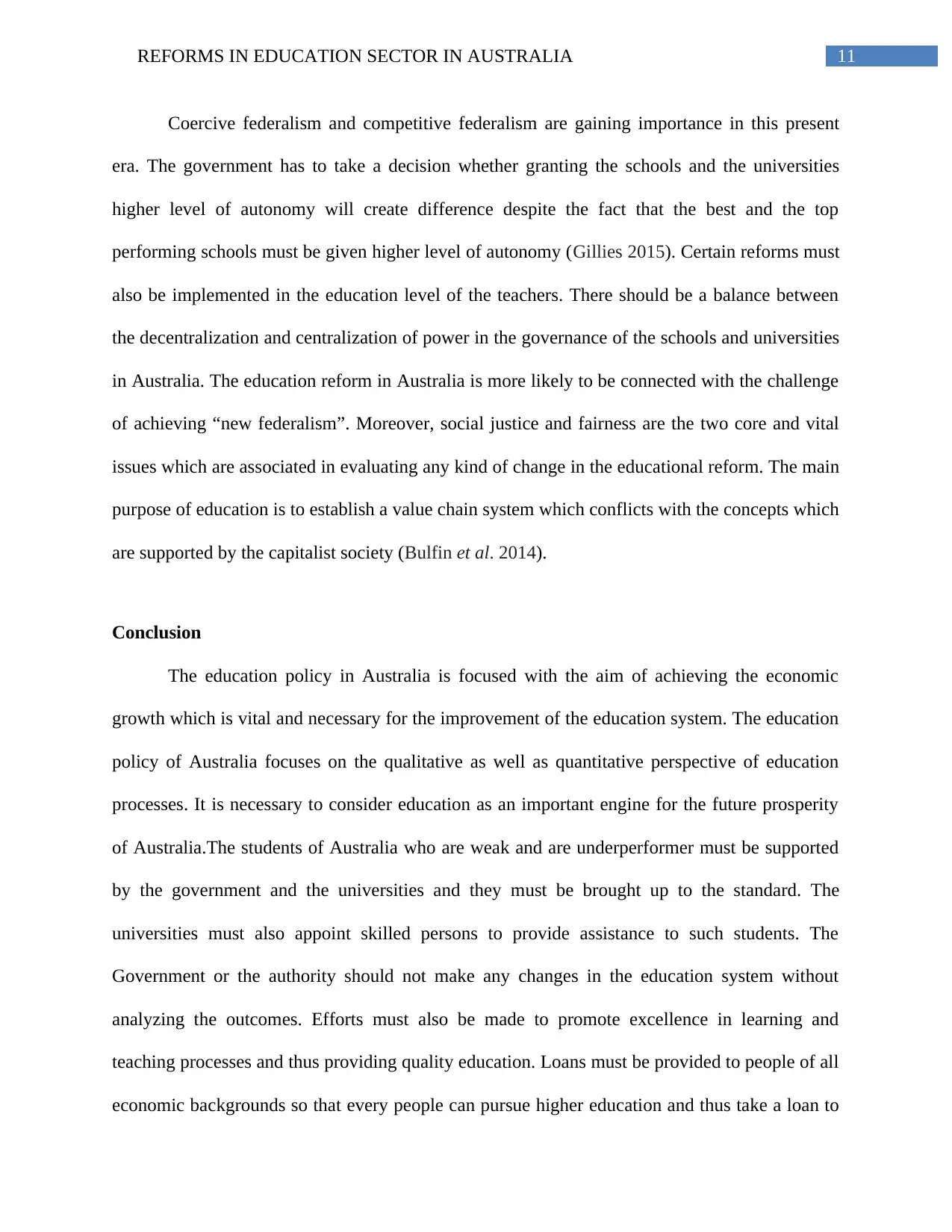
11REFORMS IN EDUCATION SECTOR IN AUSTRALIA
Coercive federalism and competitive federalism are gaining importance in this present
era. The government has to take a decision whether granting the schools and the universities
higher level of autonomy will create difference despite the fact that the best and the top
performing schools must be given higher level of autonomy (Gillies 2015). Certain reforms must
also be implemented in the education level of the teachers. There should be a balance between
the decentralization and centralization of power in the governance of the schools and universities
in Australia. The education reform in Australia is more likely to be connected with the challenge
of achieving “new federalism”. Moreover, social justice and fairness are the two core and vital
issues which are associated in evaluating any kind of change in the educational reform. The main
purpose of education is to establish a value chain system which conflicts with the concepts which
are supported by the capitalist society (Bulfin et al. 2014).
Conclusion
The education policy in Australia is focused with the aim of achieving the economic
growth which is vital and necessary for the improvement of the education system. The education
policy of Australia focuses on the qualitative as well as quantitative perspective of education
processes. It is necessary to consider education as an important engine for the future prosperity
of Australia.The students of Australia who are weak and are underperformer must be supported
by the government and the universities and they must be brought up to the standard. The
universities must also appoint skilled persons to provide assistance to such students. The
Government or the authority should not make any changes in the education system without
analyzing the outcomes. Efforts must also be made to promote excellence in learning and
teaching processes and thus providing quality education. Loans must be provided to people of all
economic backgrounds so that every people can pursue higher education and thus take a loan to
Coercive federalism and competitive federalism are gaining importance in this present
era. The government has to take a decision whether granting the schools and the universities
higher level of autonomy will create difference despite the fact that the best and the top
performing schools must be given higher level of autonomy (Gillies 2015). Certain reforms must
also be implemented in the education level of the teachers. There should be a balance between
the decentralization and centralization of power in the governance of the schools and universities
in Australia. The education reform in Australia is more likely to be connected with the challenge
of achieving “new federalism”. Moreover, social justice and fairness are the two core and vital
issues which are associated in evaluating any kind of change in the educational reform. The main
purpose of education is to establish a value chain system which conflicts with the concepts which
are supported by the capitalist society (Bulfin et al. 2014).
Conclusion
The education policy in Australia is focused with the aim of achieving the economic
growth which is vital and necessary for the improvement of the education system. The education
policy of Australia focuses on the qualitative as well as quantitative perspective of education
processes. It is necessary to consider education as an important engine for the future prosperity
of Australia.The students of Australia who are weak and are underperformer must be supported
by the government and the universities and they must be brought up to the standard. The
universities must also appoint skilled persons to provide assistance to such students. The
Government or the authority should not make any changes in the education system without
analyzing the outcomes. Efforts must also be made to promote excellence in learning and
teaching processes and thus providing quality education. Loans must be provided to people of all
economic backgrounds so that every people can pursue higher education and thus take a loan to
⊘ This is a preview!⊘
Do you want full access?
Subscribe today to unlock all pages.

Trusted by 1+ million students worldwide
1 out of 16
Related Documents
Your All-in-One AI-Powered Toolkit for Academic Success.
+13062052269
info@desklib.com
Available 24*7 on WhatsApp / Email
![[object Object]](/_next/static/media/star-bottom.7253800d.svg)
Unlock your academic potential
Copyright © 2020–2025 A2Z Services. All Rights Reserved. Developed and managed by ZUCOL.





